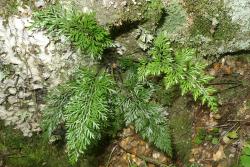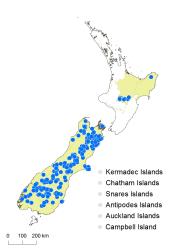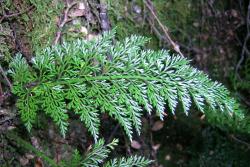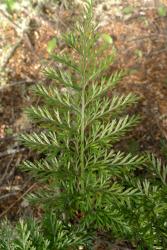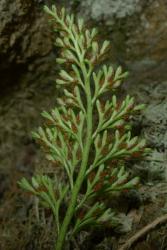- ≡ Asplenium adiantoides var. richardii (Hook.f.) Hook.f. in Hooker, Icon. Pl. 10, t. 977 (1854)
- ≡ Asplenium raoulii var. richardii (Hook.f.) Mett., Abh. Senckenberg. Naturf. Ges. 3: 162 (1859)
Terrestrial or rupestral ferns. Rhizomes short, erect, bearing scales. Rhizome scales narrowly ovate with filiform apices, 6–15 mm long, 0.7–1.5 mm wide, dark brown, clathrate. Fronds 40–470 mm long. Stipes 15–230 mm long, brown proximally and abaxially, green distally and adaxially, bearing narrowly ovate scales with filiform apices. Rachises green, slightly scaly. Laminae 2-pinnate-pinnatifid to 4-pinnate, ovate or narrowly ovate, gradually tapering to a pinnatifid apex, 25–310 mm long, 20–150 mm wide, dark green on both surfaces, herbaceous to coriaceous, bearing scattered scales, lacking hairs. Primary pinnae in 5–20 overlapping pairs below pinnatifid apex, not flattened into one plane; proximal pinnae ovate or broadly ovate, those at mid-lamina ovate; the longest at or near the base, 10–120 mm long, 5–40 mm wide, apices acute or acuminate, bases stalked; costae of primary pinnae not winged or winged only distally. Secondary pinnae gradually decreasing in length along each primary pinna to the distal end; the longest proximal secondary pinnae ovate or elliptic, 6–30 mm long, 3–15 mm wide, apices acute, bases stalked or sessile; the distal secondary pinnae linear, apices acute, bases adnate. Tertiary pinnae ovate or elliptic or linear, 3–15 mm long, 1–8 mm wide, sometimes themselves deeply or completely divided into ultimate segments 3–10 mm long and 0.5–1 mm wide. Sori submarginal; indusia 1.5–4 mm long, straight; free margins of indusia entire. Mean spore size 44–49 μm long, 32–36 μm wide; perispores prominently winged and ridged.
Asplenium richardii is morphologically similar to both A. hookerianum and A. appendiculatum subsp. appendiculatum but differs from both in having fronds with overlapping pinnae that often spread in three dimensions when fresh. It is a more robust plant than A. hookerianum, and grows at generally higher altitudes; it is also octoploid rather than tetraploid with larger spores (44–49 × 32–36 μm cf. 31–37 × 23–27 μm). It has thinner fronds, shorter indusia (1.5–4 mm, cf. 2–8 mm long), and ultimate segments that are generally narrower (0.5–1 mm, cf. 1–2.5 mm wide) than in A. appendiculatum.
North Island: Volcanic Plateau, Gisborne.
South Island: Western Nelson, Sounds-Nelson, Marlborough, Westland, Canterbury, Otago, Southland, Fiordland.
Altitudinal range: 200–1950 m.
In the North Island Asplenium richardii is known only from a few localities in montane and subalpine areas between 1000 and 1950 m; it has been recorded from Mt Honokawa, Mt Ruapehu, and the Kaimanawa Ranges. In the South Island the species is widespread from the Marlborough Sounds to Fiordland in lowland and montane areas, extending locally into the subalpine zone, mainly east of the main divide. It ranges from 200 m at Lake Te Anau up to 1525 m in the Richmond Range, Marlborough, but is mostly found above 600 m. It does not extend to Stewart Island or the subantarctic islands.
Asplenium richardii occurs under podocarp, broadleaved and beech forest, under kānuka and scrub, and occasionally in subalpine tussock. It grows terrestrially, often among rocks and boulders, on stream banks and rock faces, under rock overhangs, and in rock crevices. It is found on greywacke, andesite, rhyolite, granite, schist, limestone, and marble.
There is evidence that A. richardii hybridises with A. appendiculatum subsp. appendiculatum (Brownsey 1977a) and A. gracillimum (newly recorded here).
n = 144 (Brownlie 1954; Brownsey 1977b).
The names Asplenium richardii and A. adiantoides var. richardii, based on the same type, were both published by Joseph Hooker just days apart in 1854. However, publication at species rank occurred slightly earlier and therefore takes priority (Brownsey & Perrie 2017b). In any case the combination A. adiantoides var. richardii (Hook.f.) Hook.f. is incorrect and cannot be used because A. adiantoides Raoul is a later homonym and therefore illegitimate, even though the varietal epithet itself is legitimate. Similarly, the combination Asplenium raoulii var. richardii (Hook.f.) Mett. is incorrect and cannot be used because the name A. raoulii was nomeclaturally superfluous when published (see Notes under A. hookerianum).
Allan (1961) indicated that the type of A. richardii was in Achille Richard’s Herbarium at P, a statement repeated by Brownsey (1977b). However, that is incorrect. The species was described and illustrated by J.D. Hooker (in Hooker 1854) based on a specimen that "was given to us by our late friend Professor A. Richard, it formed part of a small collection made at the South extremity of New Zealand by the Captain of a French Whaler". Hooker further stated that "we have seen no other specimens". The specimen in K (barcode K 001092539) from New River matches Hooker’s illustration and is therefore the holotype.
The specimen itself is not the plant currently known as A. richardii, but is a narrow-pinnuled form of A. gracillimum (Brownsey & Perrie 2017b). Strict interpretation of the Code would mean that the name A. richardii should be used for what is currently called A. gracillimum, and that the plant currently called A. richardii would require a new name. However, implementation of these changes would be extremely confusing and a proposal has been submitted to Taxon (Brownsey & Perrie 2017a) to conserve the name A. richardii with a different type from that designated by Hooker (Mt Cook, Black Birch Stream, 11 Feb. 1974, Brownsey NZ 419, WELT P016203). Until a decision is made, the current nomenclature still applies. If the proposal is rejected, changes to the names of two species and 10 hybrid combinations will be required, as detailed by Brownsey & Perrie (2017b).
Analysis of morphology and low-copy nuclear DNA sequences suggests that A. richardii is an autopolyploid species derived from A. hookerianum (Shepherd et al. 2008).



